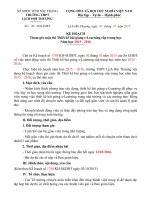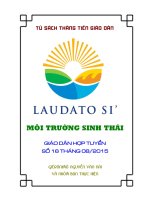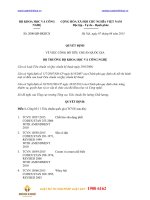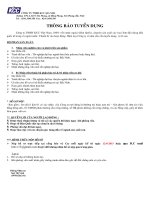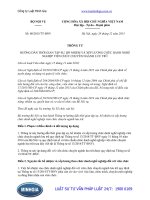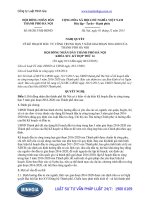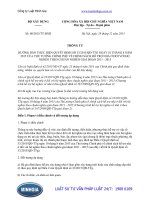E 501 08 (2015)
Bạn đang xem bản rút gọn của tài liệu. Xem và tải ngay bản đầy đủ của tài liệu tại đây (182.72 KB, 4 trang )
Designation: E501 − 08 (Reapproved 2015)
Standard Specification for
Standard Rib Tire for Pavement Skid-Resistance Tests1
This standard is issued under the fixed designation E501; the number immediately following the designation indicates the year of
original adoption or, in the case of revision, the year of last revision. A number in parentheses indicates the year of last reapproval. A
superscript epsilon (´) indicates an editorial change since the last revision or reapproval.
1. Scope
3. Materials and Manufacture
1.1 This specification covers the general requirements for
the standard rib tire for pavement skid-resistance testing. The
tire covered by this specification is for use in evaluation of
tire-pavement friction.
3.1 The individual standard tires shall conform to the design
standards of Section 5. Dimensions, weights, and permissible
variations are given in Section 6 and in Fig. 1 and Fig. 2.
3.2 Tread compounding, fabric processing, and all steps in
tire manufacturing shall be certified to ensure that the specifications are met.
1.2 The terminology in this specification is consistent with
Terminology E867.
1.3 The values stated in inch-pound units are to be regarded
as standard. The values given in parentheses are mathematical
conversions to SI units that are provided for information only
and are not considered standard.
3.3 A small raised guideline shall be molded on the tire
shoulder area to provide a rapid visual check as to whether the
maximum wear level for testing has been reached. Tires should
actually be removed from service as recommended in 11.5. The
marking on the tire, as suggested in Fig. 1, and curb ribs shall
be molded on both sides of the tire.
2. Referenced Documents
2.1 ASTM Standards:2
D297 Test Methods for Rubber Products—Chemical Analysis
D412 Test Methods for Vulcanized Rubber and Thermoplastic Elastomers—Tension
D1054 Test Method for Rubber Property—Resilience Using
a Goodyear-Healey Rebound Pendulum (Withdrawn
2010)3
D1765 Classification System for Carbon Blacks Used in
Rubber Products
D2240 Test Method for Rubber Property—Durometer Hardness
D3182 Practice for Rubber—Materials, Equipment, and Procedures for Mixing Standard Compounds and Preparing
Standard Vulcanized Sheets
E867 Terminology Relating to Vehicle-Pavement Systems
3.4 Fig. 1 is a photograph of the standard tire, and Fig. 2 is
a cross section of a typical tire.4
3.5 Tire should be mounted so that it is rotated in the
direction of the arrow on the side of the tire. See Fig. 1.
4. Material Requirements
4.1 The compounding requirements for the tread compound
are given in Table 1.
4.2 Fabric—The fabric shall be polyester body or carcass
plies and fiber glass belt plies.
NOTE 1—Certain proprietary products have been specified since exact
duplication of properties of the finished tire may not be achieved with
other similar products. This inclusion does not in any way comprise a
recommendation for these proprietary products nor against similar products of other manufacturers, nor does it imply any superiority over any
such similar products.
5. Physical Requirements
5.1 The physical and mechanical test requirements are given
in Table 2.
1
This specification is under the jurisdiction of ASTM Committee E17 on Vehicle
- Pavement Systems and is the direct responsibility of Subcommittee E17.24 on Tire
and Slider Characteristics.
Current edition approved Sept. 1, 2015. Published December 2015. Originally
approved in 1973. Last previous edition approved in 2008 as E501 – 08. DOI:
10.1520/E0501–08R15
2
For referenced ASTM standards, visit the ASTM website, www.astm.org, or
contact ASTM Customer Service at For Annual Book of ASTM
Standards volume information, refer to the standard’s Document Summary page on
the ASTM website. DOI: 10.1520/E0501-08.
3
The last approved version of this historical standard is referenced on
www.astm.org.
6. Dimensions, Weights, and Permissible Variations
6.1 General—Details of dimensions are listed as follows
and are shown in Fig. 2. When tolerances are not specified, tire
dimensions are subject to manufacturer’s normal tolerances.
4
ASTM E501 tire is available from Specialty Tires of America, P.O. Box 749,
1600 Washington St., Indiana, PA 15701.
Copyright © ASTM International, 100 Barr Harbor Drive, PO Box C700, West Conshohocken, PA 19428-2959. United States
1
E501 − 08 (2015)
Marking on Tire
G78–15
Standard Pavement Test Tire—Not for General Highway Use
ASTM Designation: E501
Manufacturer’s Name or Trademark
Rim: 15x6JJ
FIG. 1 Test Tire
FIG. 2 Tire Section, Including Inflated Tire Dimensions
6.1.1 Construction—The tire shall be a size G78-15 tubeless
type, belted bias construction (two body plies plus two belt
plies). The tread width shall be 5.85 in. (148.6 mm) and the
cross-sectional tread radius shall be 15.50 6 2.0 in. (393.76
50.8 mm). The tire shall have a recommended cross-section
width of 8.35 in. (212.1 mm) and a recommended section
height of 6.34 in. (161.0 mm) when mounted on a Tire and Rim
2
E501 − 08 (2015)
TABLE 1 Compounding of Tread RubberA
Material
PPHR
SBR 1712B
BR 1208C
Zinc oxide
Stearic acid
Paraffin wax
N339D
6PPDE
High aromatic oil
TBBSF
DPGG
Sulfur
89.38
35.00
3.00
2.00
2.00
75.00
2.00
22.12
1.10
0.10
1.80
8.5 Specific Gravity—Test Methods D297.
8.6 Tensile Strength—Test Methods D412.
8.7 Elongation—Test Methods D412.
8.8 Tire Tread Durometer—Test Method D2240, in addition
to the following specific procedures:
8.8.1 Use a Type A durometer. (A 0.5-in. (12.7-mm) diameter presser foot, Shore, code XAHAF is recommended.)
8.8.2 The durometer shall be calibrated at a reading of 60
hardness.
8.8.3 Condition the tire and durometer to equilibrium at
73.4 6 3.6°F (23 6 2°C) before determining tread hardness.
8.8.4 The tire tread hardness is to be determined by averaging at least one set of six readings. A set is one reading taken
in the center of each rib, excluding the center rib. It is
recommended that additional sets of readings be taken around
the tread circumference.
8.8.5 Apply presser foot to the tire tread as rapidly as
possible without shock, keeping the foot parallel to the tread
surface. Apply just sufficient pressure to obtain firm contact
between presser foot and tire tread surface. Read the durometer
scale within 1 s after presser foot is in contact with the tire
tread, but after initial maximum transient which may occur
immediately after contact is made.
A
See Practice D3182.
Styrene-butadiene rubber (23.5 % styrene) 37.5 parts of high-aromatic oil.
High cis-polybutadiene.
D
N339 Carbon Black, see Classification D1765.
E
Dimethyl butylphenyl phenylenediamine.
F
Butyl benzothiazole sulfenamide.
G
Diphenyl guanidine.
B
C
TABLE 2 Physical Properties of Tread Compound
Tensile Sheet Cure, min. at 302°F (150°C)
300 % modulus, psi (Test Methods D412)
Specific gravity (Test Methods D297)
Tensile strength, min psi (Test Methods D412)
Elongation, min % (Test Methods D412)
Tire tread durometer (Test Method D2240)
30
1000 ± 200
1.13 ± 0.02
2000
500
58 ± 2
9. Certification
9.1 Tires are to be inflated and measured prior to shipment.
Upon request, the manufacturer shall furnish the purchaser
certification that the test tire meets this specification.
Association 15 by 6JJ rim. The cured crown angles shall be 33
6 2° for the body plies, and 27 6 2° for the belt plies.
6.1.2 Ribs—The tire shall have seven plain ribs of 0.66 in.
(16.8 mm) width each. Both sides of the shoulder ribs shall be
parallel from the tread surface down to a depth equal to the
wear guideline.
6.1.3 Grooves—The tire shall have six straight grooves of
0.20 in. (5.08 mm) width each. Each groove shall be parallel to
the radius of the tread-radius arc and shall have a full radius at
the bottom of the groove. Each groove shall have a uniform
skid depth of 0.385 in. (9.8 mm) maximum and shall have an
under-tread thickness of 0.10 in. (2.5 mm).
6.1.4 Wear Indicators—There shall be six rows of tread
wear indicators spaced uniformly around the tire circumference
and directly across the full tread width in all six grooves. These
tread wear indicators shall be 0.063 in. (1.6 mm) deep and
approximately 0.50 in. (12.7 mm) long. A visual wear guideline
shall be located on the shoulder of the tire 0.22 in. (5.6 mm)
from the tread surface as shown in Fig. 2.
9.2 All tires under certification shall be subject to the
manufacturer’s normal variation.
10. Packaging and Preservation
10.1 The tires should be kept dry under ordinary atmospheric conditions in subdued light, 70 6 25°F (21 6 13.8°C).
Tires should not be stored near electric motors, welders, or
other ozone generating equipment.
11. Recommendations for Tire Use and Operational
Requirements
11.1 The tire is for skid testing only and is not designed for
general highway service. Necessary transport of test equipment
should be on commercial tires.
11.2 A new tire break-in of 200 miles (320 km) minimum
should be made on tires by the purchaser before using the tire
for testing.
7. Workmanship
11.3 The tire shall be operated with not less than 24 psi (165
kPa) inflation.
7.1 Tires shall be free of defects in workmanship and
material.
11.4 The recommended static test load on the tire shall be
1085 lbf (4826 N), with loading to a maximum of 1380 lbf
(6138 N) permissible, at 24 psi (165 kPa) inflation.
8. Test Methods
8.1 Tensile Sheet Cure—Practice D3182.
8.3 Tensile Sheet Durometer—Test Method D2240, using a
Type A Shore durometer.
11.5 When irregular wear or damage results from tests or
when the remaining groove depth in any groove is 0.165 in.
(4.2 mm) or less, the use of the tire as a standard test tire shall
be discontinued.
8.4 Restored Energy (Rebound or Resilience)—Test Method
D1054.
11.6 Caution—Measured friction force and skid number
(SN) may be influenced by tire groove depth, or tread hardness,
8.2 Modulus (300 %)—Test Methods D412.
3
E501 − 08 (2015)
or both. The magnitude of this dependence is a function of the
water depth, pavement characteristics, test speed, and tire
aging effects.
ASTM International takes no position respecting the validity of any patent rights asserted in connection with any item mentioned
in this standard. Users of this standard are expressly advised that determination of the validity of any such patent rights, and the risk
of infringement of such rights, are entirely their own responsibility.
This standard is subject to revision at any time by the responsible technical committee and must be reviewed every five years and
if not revised, either reapproved or withdrawn. Your comments are invited either for revision of this standard or for additional standards
and should be addressed to ASTM International Headquarters. Your comments will receive careful consideration at a meeting of the
responsible technical committee, which you may attend. If you feel that your comments have not received a fair hearing you should
make your views known to the ASTM Committee on Standards, at the address shown below.
This standard is copyrighted by ASTM International, 100 Barr Harbor Drive, PO Box C700, West Conshohocken, PA 19428-2959,
United States. Individual reprints (single or multiple copies) of this standard may be obtained by contacting ASTM at the above
address or at 610-832-9585 (phone), 610-832-9555 (fax), or (e-mail); or through the ASTM website
(www.astm.org). Permission rights to photocopy the standard may also be secured from the Copyright Clearance Center, 222
Rosewood Drive, Danvers, MA 01923, Tel: (978) 646-2600; />
4

